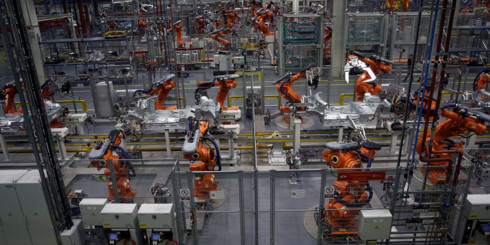Economic development is not a linear formula for each and every country to blindly follow, and one of the most important stepping stones, the industrial revolution, seems to be coming loose as technology and automation are reshaping production and trade.

The developed world has made leaps and bounds by industrialisation and building out low-skill, labour-intensive manufacturing lines to stand where they are now.
Many lower-income countries jumping on the bandwagon later on have achieved spectacular economic growth by shifting to low-end manufacturing that is exceptionally labour-intensive, like textile and garment and footwear production where workers coming from low-productivity smallholder agriculture could be easily trained to task.
Indeed, as reported by The Guardian, industrialisation has driven an “unprecedented convergence between rich and poor country wealth levels,” as by the early 2000s 83 developing countries were growing at twice the rate of OECD members.
However, simply following the footsteps of developed countries is not viable as the gains of industrialisation and low-skill manufacturing are being eroded by the emergence of automation.
Harvard economist Dani Rodrik, as cited by The Guardian, said industrialisation is rapidly losing its magic: most developed countries have gotten richer than the countries that follow after them and are now turning away from manufacturing.
By Rodrik’s calculations, industrialisation peaked in western European countries, such as Britain, Sweden, and Italy at income levels of around $14,000 (1990 levels), while it peaked in India and Sub-Saharan African countries at $700 (1990 levels). In fact, Latin America and Africa, the latest joiners of industrialisation, are already showing signs of deindustrialisation.
The biggest challenge to manufacturing is automation and the fast developing computing capacity. As computers evolve, machines can learn more and more low-skill tasks and take over with more precision and speed. Bear in mind, it is mostly low-skilled jobs that are in danger, while medium and high-skilled positions are relatively safe.
A major advantage offered by countries delving into industrialisation is the abundance of cheap, unskilled labour force. If this is undercut by automation, there will be little left going for manufacturing countries and large-scale international companies may elect to take production closer to the end users.
Adidas, as reported by The Economist, has already started building an automated factory in its home country Germany. Apart from the fact that this novel production facility will use a range of advanced techniques, such as 3D printing, to produce customised trainers and sports shoes for order, it is a definitive step away from favoured offshore production countries like China, Indonesia, and Vietnam.
Vietnam, China, and India are somewhat luckier as they ran in the second wave of industrialists and have attained middle income status by it. Slower economies hoping to take the same path ended less fortunate.
However, automation is becoming an increasing concern for all the countries that make up the manufacturing backbone of global industrial production. As reported by Bloomberg, installing robots along production lines is threatening to dent wages in China and impact the world at large.
The International Labour Organization in the publication of “ASEAN in Transformation: the Future of Jobs at Risk of Automation” has reported that an alarming number of enterprises in Camdobia, Indonesia, the Philippines, Thailand, and Vietnam (named the ASEAN 5 by the report) are at high-risk of automation in the next couple of decades. 56 per cent of all employment, nearly three out of five jobs, have a high risk of automation in the five countries.
In fact, the risk is the worst in Vietnam, as about 70 per cent of jobs are in the high-probability zone of being replaced by machinery. Additionally, another 18 per cent of jobs has a medium risk, and only 12 per cent of all employment carries low risk of automation.
According to the ILO report, the share of low-skilled elementary occupations in total employment is the highest in Vietnam, with two out five jobs belonging to this category. Thus, the overall probability of computerisation is also the most pronounced.
VIR